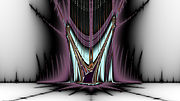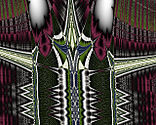-
High-quality deep-zoom image of a small ship in the armada in the left Western antenna of the main ship structure
-
Burning Ship deep zoom to 2.3·10−50
-
The Burning Ship fractal
-
A zoom-in to the lower left of the Burning Ship fractal, showing a "burning ship" and self-similarity to the complete fractal
-
A zoom-in to line on the left of the fractal, showing nested repetition (a different colour scheme is used here)
-
High-quality image of the Burning Ship fractal
-
The Burning Ship fractal featured in the 1K intro "JenterErForetrukket" by Youth Uprising; a demoscene production
-
Ghost Ship - The Burning Ship fractal rendered using the Nebulabrot technique
-
A corresponding Julia set of Burning Ship fractal
-
A corresponding Julia set of Burning Ship fractal
-
High resolution image of the burning ship fractal
-
The structure of the Burning Ship fractal





The Burning Ship fractal, first described and created by Michael Michelitsch and Otto E. Rössler in 1992, is generated by iterating the function:
in the complex plane which will either escape or remain bounded. The difference between this calculation and that for the Mandelbrot set is that the real and imaginary components are set to their respective absolute values before squaring at each iteration.[1] The mapping is non-analytic because its real and imaginary parts do not obey the Cauchy–Riemann equations.[2] Note that virtually all images of the Burning Ship fractal are reflected across the -axis for aesthetic purposes, and some are also reflected across the -axis.[3]

















